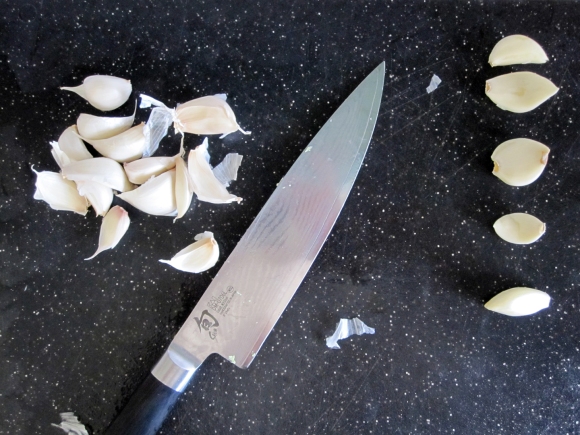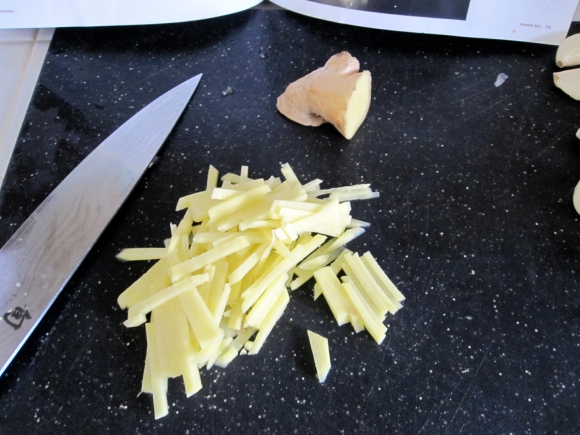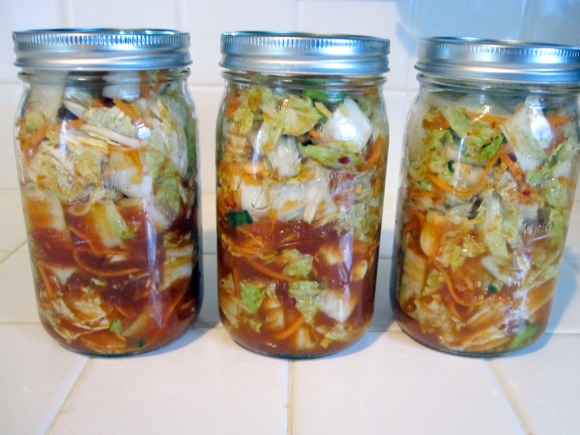Here’s what David says about his kimchi:
At Momofuku, we make three types of kimchi: Napa cabbage (paechu), radish (from long white Korean my dishes or, failing that, Japanese daikon), and Kirby cucumber (oi). Our recipe has changed some since I learned it from my mom, who learned it from her mom. I add more sugar than they would. We let the fermentation happen in the refrigerator instead of starting the kimchi at room temperature and then moving it into the fridge when it starts to get funky. At the restaurant, we let the kimchi ferment for only a couple of weeks, instead of allowing it to get really stinky and soft. There’s a point, after about two weeks, where the bacteria that are fermenting the kimchi start producing CO2 and the kimchi takes on a prickly mouthfeel, like the feeling of letting the bubbles in a soft drink pop on your tongue. It’s right around then that I like it best.
Makes 1 to 1 ½ quarts
INGREDIENTS
• 1 small to medium head Napa cabbage, discolored or loose outer leaves discarded
• 2 tablespoons kosher or coarse sea salt
• 1/2 cup plus 2 tablespoons sugar
• 20 garlic cloves, minced
• 20 slices peeled fresh ginger, minced
• 1/2 cup kochukaru (Korean chile powder)
• 1/4 cup fish sauce
• 1/4 cup usukuchi (light soy sauce)
• 2 teaspoons jarred salted shrimp
• 1/2 cup 1-inch pieces scallions (greens and whites)
• 1/2 cup julienned carrots
DIRECTIONS
Cut the cabbage lengthwise in half, then cut the halves crosswise into 1 inch wide pieces.
*
*
Toss the cabbage with the salt and 2 tablespoons of the sugar in a bowl. Let sit overnight in the refrigerator.
Combine the garlic, ginger, kochukaru, fish sauce, soy sauce, shrimp, and remaining ½ cup sugar in a large bowl. If it is very thick, add water 1/3 cup at a time until the brine is just thicker than a creamy salad dressing but no longer a sludge.
Stir in the scallions and carrots.
*
*
*
*
*
*Drain the cabbage and add it to the brine. Cover and refrigerate. Though the kimchi will be tasty after 24 hours, it will be better in a week and at its prime in 2 weeks. It will still be good for another couple weeks after that, though it will grow stronger and funkier.
*
I double his recipe to make 3 quarts. Also, I make the liquid sauce with the carrots and the scallions at the same time that I chop and salt the cabbage. I let them both sit overnight, then in the morning I just drain the cabbage, pour the sauce over the top, and mix it up good with my hands and pack it into mason jars. You can eat it almost immediately without feeling bad about it at all. But like David says, it just gets better the longer it ferments.
I try to make this often enough that I don’t run out between batches, but I never make it.
This is such an amazing staple of garlicky goodness you can’t believe it. I put out a bowl of this any time we’re eating anything vaguely eastern in origin. Just a couple of bites of this sharp, pungent, brilliant kimchi makes a meal come alive. Its goodness is an emergent property that does not exist in any of the ingredients taken alone. Only after combining them and letting them stew in the juice of their own concocting does the miracle of kimchi occur.
To our everlasting benefit.
World without end, amen.
*
Namaste.
***












I used to have a very good skin, lately my pores seem so
huge. Is it because my skin is dehydrated or stress? I also have
a slight melasma and have been using cosmelan to treat it.
Maybe cosmelan made my skin weak? Please, help.
I enjoy what you guys are up too. This type of clever work
and coverage! Keep up the awesome works guys
I’ve you guys to our blogroll.
[…] https://plateandfork.wordpress.com/2012/04/07/david-changs-napa-cabbage-kimchi/ […]